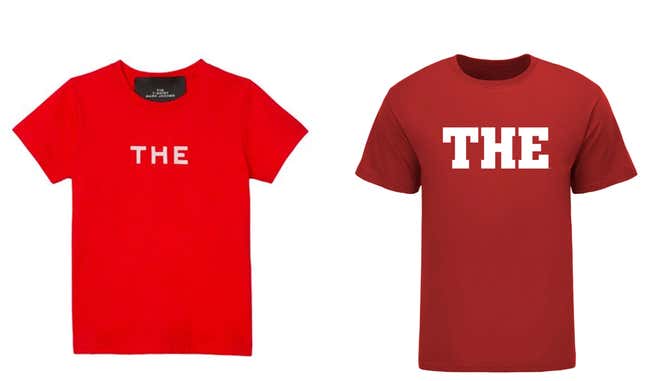The Ohio State University has successfully trademarked the word “the.”
In a June 21 notice, the US Patent and Trademark Office granted the 152-year old research institution exclusive use of the article for college merchandise such as t-shirts, baseball caps, hats, and other team sports swag.
The ruling is a culmination of the university’s three-year legal campaign, which involved negotiating a settlement with fashion house Marc Jacobs, that had held trademark to the word. The LVMH-owned brand had been using “THE” in purses, sweaters, and $100 t-shirts. Ohio State challenged Marc Jacobs’s trademark to protect its licensing business that generates an average of $12.5 million each year. The two entities have agreed to share the trademark to the word.
Ohio State and Marc Jacobs have a class 25 trademark, which specifically pertains to clothing, footwear, or headgear. The article is still thankfully free to use elsewhere.

“Ohio State works to protect the university’s brand and trademarks because these assets benefit students and faculty, and support our core academic mission of teaching and research,” explained university spokesperson Ben Johnson. “Buckeye fans who purchase official Ohio State gear support student scholarships, libraries and other university initiatives.”

The linguistic weight of “the”
In the mid-1980’s Ohio State started to emphasize the word “the” in its name, to distinguish it from other US universities with the same initials (OSU) such as Oklahoma State University and Oregon State University.
In the mid-1990s football coaches asked Ohio State players to emphasize the article when saying the university’s name. During roll calls, athletes pronounce “the” like an honorary title, as in “THE Queen.”
Putting weight on “the” implies that that university is singular and exemplary. According to a blog entry on Ohio State’s archives, “emphasizing ‘the’ was used to show the other colleges which institution was supposed to be the leader in the state, both in size and in financial support from the legislature.”
The kerfuffle over the article has also piqued the interest of the school’s language experts. Brian Joseph, professor of linguistics at Ohio State, believes that the school’s obsession with “the” shouldn’t distort language.
“‘The’ isn’t an integral part of the [university’s] name, and in a sense at a certain abstract level isn’t really there,” he argues. For instance, Joseph explains in an email to Quartz, students enrolled at the university should be referred to as “Ohio State University students and “crucially not ‘The Ohio State University student’ which sounds terrible,” he said.
This is a point Joseph made in a commencement address (pdf) in 2007:
We are proud here to emphasize “the” and to use it as a distinctive mark of university identification; indeed, in that sense it shows how linguistic features can take on a social significance, with “the” marking a particular attitude towards and pride in your soon-to-be alma mater. We are not just “an” Ohio State University—any old one—but “the” Ohio State University! But is the part of the name or not? It certainly is officially, as it is emblazoned on our logo, but our acronym is O-S-U, not T-O-S-U…
Only one article can occur in the slot before a noun, and “the” in The Ohio State University competes for that slot, just as if it were a free word and not a meaningless piece built into the university’s name. Will this settle the controversy? Probably not, but it shows how linguistic argumentation can inform an area of inquiry near and dear to all of us.
